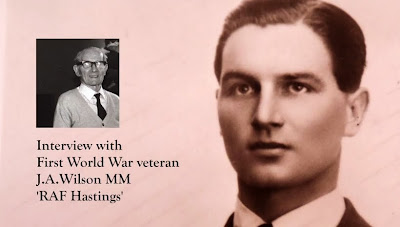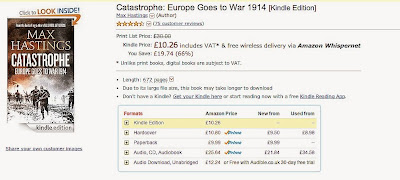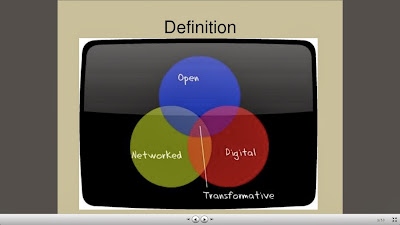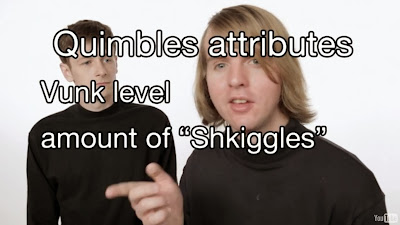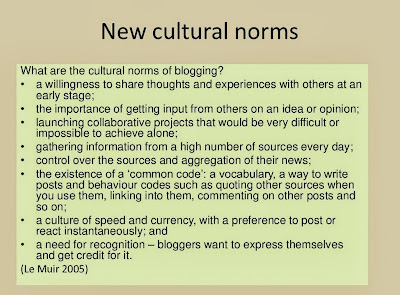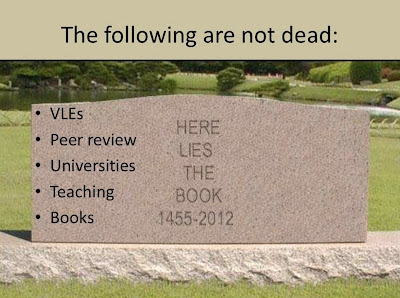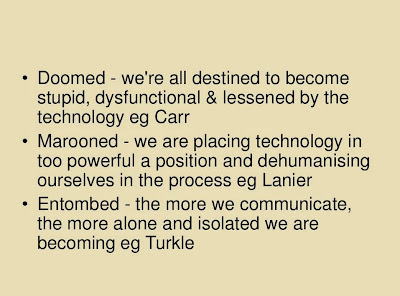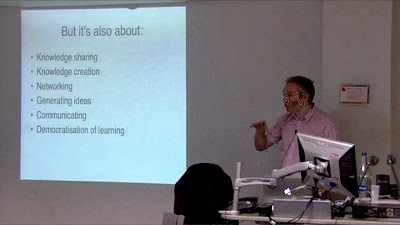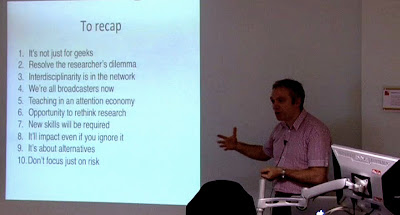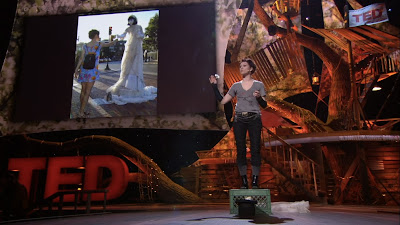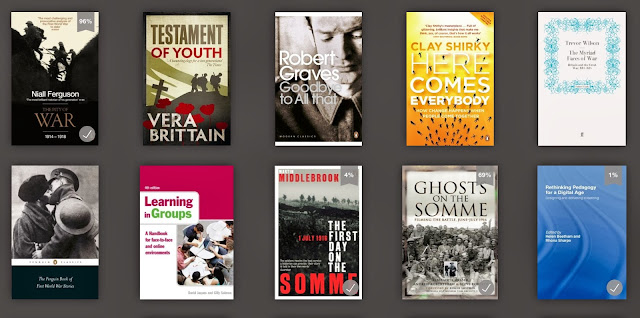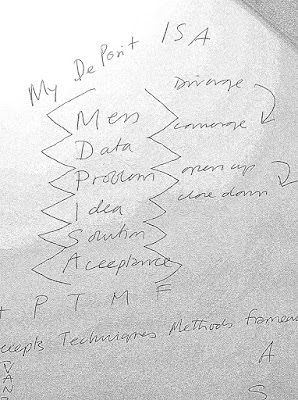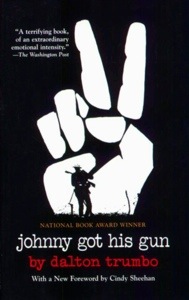 I saw the film in my early teens - on TV. I'm reading everything I can on the First World War in this the centerary year. 'Johnny got his gun' is a moving and memorable account of one young soldier's plight when he is terribly wounded and survives. The author's story and how the book was oublished then banned makes for fascinating reading too.
I saw the film in my early teens - on TV. I'm reading everything I can on the First World War in this the centerary year. 'Johnny got his gun' is a moving and memorable account of one young soldier's plight when he is terribly wounded and survives. The author's story and how the book was oublished then banned makes for fascinating reading too.Personal Blogs
 I saw the film in my early teens - on TV. I'm reading everything I can on the First World War in this the centerary year. 'Johnny got his gun' is a moving and memorable account of one young soldier's plight when he is terribly wounded and survives. The author's story and how the book was oublished then banned makes for fascinating reading too.
I saw the film in my early teens - on TV. I'm reading everything I can on the First World War in this the centerary year. 'Johnny got his gun' is a moving and memorable account of one young soldier's plight when he is terribly wounded and survives. The author's story and how the book was oublished then banned makes for fascinating reading too.Fig.1. 'Poster' constructed using a combination of 'Brushes' (to layer several photos in one) and 'Studio' a simple graphics app that provided the overlays and text. Images and screen-grabs cropped and saved into Picasa Web Albums.
Created for H818: The Networked Practitioner - towards a poster to illustrate a conference demonstration of an interactive mobile learning platform aimed at sourcing the involvement of many collaborators to enrich our understanding of this period in history.
The QR code should work, the YouTube video does not - it's a screengrab. The video clip, under 2 minutes, is there.
This is Jack Wilson's WW1 Story (blog) and here is the brief interview clip. In fairness I edited around 8 minutes down to 2 minutes, keeping one story about a young woman who came down from London to meet up and otherwise to compress the kind of circuitous conversation you can have with someone in their nineties.
Fig. 2. Jack Wilson (1896-1992) talks briefly about his few weeks military training at RAF Hastings in May/June 1918. Features several of his photographs from these weeks that he sent home to his mother in Consett, County Durham. (As YouTube doesn't embed on OU platform, link to YouTube)
Fig.3. The simplest of SimpleMind mind maps to remind me what the poster still requires and is certainly missing.
And as a reminder to me there is 2500 words to write too.
Only up because it it has sounded all night as if the roof was about to come off ... then load car with teenagers, dog and clutter to meet up with my wife and my in laws. Then 800 miles through France. I'll be back at my desk on the 6th Jan. But who needs a desk these days? I can get online from the passenger seat of the car - this summer it blew my mind to be online in a plane. It'll be considerably less pleasing to find smartphones are used as eagerly and noisily 3000m up a glacier as they are in a shopping mall. Our connectedness and desire to be so has to be the technical and social phenomenon that defines the era we are living through - I would prefer to have a chip embedded in my skin so that I wouldn't have to care about keeping the XXXXXX phone charged, on a loud enough ring so that I respond, and on my person wherever and whenever I am from something like 6.00am through to the early hours of the morning.
I'm drifting into reflection mode but at one end I am getting final calls, emails and texts from my wife (an 'owl') at 1.00am (I've been asleep for a good 2 hours) then fed up with the noise of the wind I check the BBC weather at something like 5.30 am and trigger something in Facebook that informs others that I am online and I get a message from a fellow 'lark'. Come to think about it I had might as well have been online for the hours I slept given the concoctions of my dreamworld.
- Breakfast.
- Pack car.
- Wake teenagers.
- Walk dog.
- Run through assorted check lists.
- Check weather.
- Wake teenagers.
- Go back to bed and set off later as it clears?
- Woken by phone at 11.30. Where are we???
- Wake teenagers.
- Set off.
- Arrive five hours late.
- Realise I have forgotten the dog ...
- Look forward to a power cut so that everyone's gadget dies so we can look forward to a traditional Christmas of charades, deluxe Monopoly and Twister.
CALL TO ACTION
If you or your relatives have old photos from the First World War how about sharing them and let's see of collectively we can bring these characters back to life by researching then telling them story. I'm always very interested to hear from people with a similar interest in the 'Great War' especially when it comes to the Machine Gun Corps and the Royal Flying Corps where my grandfather and great uncle served.
My WW1 blog might be the place for this.
http://www.educause.edu/ero/article/rethinking-online-community-moocs-used-blended-learning
This is fascinating and important. It was brought to my attention by a fellow student on H818:The Networked Practitioner. The differences between how a person spends their time when learning is spent whether online, say on a Massive Open Online Course (MOOC), 'tradionally' and in blended forms.
Having ways to present data in an informative and engaging way is vital. Here at a glance you can see how behaviours differ. I'm eager to read further papers on this to see how the research was undertaken and how therefore I might apply it as 'how we learn now' is of particular interest to me. The Educause article this came from offers ample further reading.
I thought these were DNA patterns. I'd like to see these charts as animations annotating and illustrating examples so that we can see and are therefore be reminded of the context. Simply put blended learning increases the time a student spends on a subject - that's as good as it needs to be from my point of view as with more and varied ways of engagement comes a developong interest, improved motivation and lasting learning formation. I rather think we blend learning anyway - once it comes off the screen 'it' interacts with the contents if your brain and is invariably shared in some form or another too.
An essay, and therefore all assignments should be for the purposes of learning. To help the tutor, even your peers, to see where your thinking has reached and add to and correct as necessary. Assessment should be the end of module dissertation or written exam.
What do you think?
It's as good a reason as any to stop for a while. But of course it doesn't. In fact I'd say the revelations of the last week have been extraordinary and impossinle without the required - stop.
It came walking the dog in 'Bluebell Woods' (that's Spring). Today we we have acres of larch shedding their leaves .... just an intermittent breeze and a shoer of leaves rattle down through the arching branches above.
I took photos. I even hung around 'til I could video it.
I was reminded immediatly of the Menin Gate, Ypres and the thousands of petals that are thrown from above.
I had an idea for the leaves ... and an even greater one for them falling from above.
Tag 'em all.
Fig. 1. Dr. No
Society online is a society on speed and at speed - it might reflect society but in the Alice in Wonderland World Wide Web everything is faster, connectable and so warped in a way that transcends human scales of time, distance and decency. One sick, warped, isolated individual seeking out the pollution of the web to feed their fantasy and make it real, like Anders Behring Breivik in Norway in 2011 was, if you profile the population, 1 in 10 million.
What happens when connected as 'like-minds' six or seven such individuals 'collaborate' to perform some atrocity?
What indeed does the web afford 'networked' terrorist idealists such as AL Qaeda? Attending a seminar on cyber crime at the Oxford Internet Institute last year it was revealing and shocking to learn of the 'game of catch-up' played between the criminals hacking bank accounts and the banks trying to keep them secure. The head of internet security from Barclays paintied a picture that would make the scriptwriters of a James Bond movie go googled-eyed in amazement. Then, far from society creating the Web, the web world infects us 'on the other side' with paranoia and so CHANGES behaviour, gets AHEAD of society. It has happened to me more than once - in the early days of blogging back in 2002 I was 'flamed' visciously (malicious hate in comments and a breach into my blog that had this person editing my content and filling it with bile). I had this stopped and attempts were made to trace the character but for a period I was convinced that any vehicle pulling up along our street outside our house was 'him' ... and then this summer I put webcams around the house when we went away from a few weeks and only after the first week did I relax when I noticed that a brick hadn't come through the window and we hadn't been burgled or the house burned down.
It doesn't get any better.I thought I was on top of this by now, like riding a bike, but you don't really know what kind of a beast you have a hold of until you tackle it. All the more reason to get an early draft written and give yourself a week or two to work on it. This would have been fine but the entire process leading up to H818 TMA1 has been to expand, share, search, explore ... and so it went on until like the incredible stretching man my arms reached west to Dublin and east to the Urals. Part One had a work count limit of 1500. My first draft came in at 4,600. I hacked this down by 50% then did the wise thing and began again from scratch working on the basis they I had some juicy content in my head, I just needed to focus.
A mind map with a mere 7 links on it did the job. 200 words for each and 100 words to share across an introduction and conclusion ... sort of.
I'd references the longer version in my enthusiasm so had to unpick that - there is only one thing worse than missing out a lot of references, is referencing a lof of stuff that is no longer there.
Then part two.
For reasons only known to the OU IT team I couldn't zip two documents on my Mac so emailed the documents to my wife - I am sitting at her laptop now. The period between sending these files from my office 11 miles away and cooking supper (I do) gave me a chance to dwell on a sentence regarding part two
Students are encouraged to be bold and innovative in setting forth a project proposal.
A breathing space, a chance to reflect, a deadline fast being overdue ... so I went for it. Controversy gets attention. So does death. This has both. And if I play my cards right I'll need to find an actor, dress him up, get some make up then film them in their final moments.
What's going on in there? How do bloggers react, respond and coalesce?
Anjewierden, A. (2006) Understanding Weblog Communities Through Digital Traces: A Framework, a Tool and an Example.
My own interest was sparked by an article in the Washington Post on Ellen Levy who had spent 1998 keeping a journal and putting it online.
Druckerman, P (1999) Ellen Levy Has Got The Write Project For the Internet Age --- It's a Year of Scribbling Down Almost Everything; Ah, Yes, It Was a Raisin Bagel
This ‘user generated content’ has value to its author and the community that reads it. This is a key outcome of open, collaborative and connected learning, where the blogger is a ‘produser’.
Efimova, Lilia (2008) Bloggers and 'produsers'
Having blogged consistently since this period it is interesting to understand that as it encroached upon student and academic practice, as it was impinging on journalism, that it was considered disruptive.
Fiedler, S. (2004) Introducing disruptive technologies for learning: Personal Webpublishing and Weblogs, Part I
While my passion felt like a niche practice it has been of value to see blogging recognised.
Kaiser, S. (2007) Weblog-technology as a trigger to elicit passion for knowledge
Why MAODE students blog (Kerewella et al, 2009) depends on their perceptions of, and for:
- an audience
- community
- the utility of and need for comments
- presentational style of the blog content
- overarching factors related to the technological context
- the pedagogical context of the course
Kerawalla, L, Minocha, S, Kirkup, G, & Conole, G (2009) An empirically grounded framework to guide blogging in higher education
Knowing the practice to be of value personally as part of a number of specialist groups made research on blogs as wikis, Sauer (2005) or as e-portfolios of interest.
Sauer, Igor M. (2005) “ Blogs” and“ Wikis” Are Valuable Software Tools for Communication Within Research Groups
As Smolkin (2007) points out it is about creating or finding and then sharing your niche - in this case the niche being personal stories of participants, witnesses and combatants in the First World War.
Smolkin, Rachel (2007) Finding a Niche. (cover story)
This is a key outcome of open, collaborative and connected learning, where the blogger is a ‘produser’. Efimova (2008) It has taken over a decade, but blogging is now considered to be a valid, scholarl acitivity. Weller (2012).
Weller, Martin (2012) The virtues of blogging as scholarly activity
Bishop, D. (2013) ‘Blogging as post-publication peer review: reasonable or unfair?’ LSE Impact of Social Sciences blog. 21 March.
Available at:http://blogs.lse.ac.uk/
impactofsocialsciences/ 2013/ 04/ 15/ blogging-as-post-publication-peer-review-reasonable-or-unfair/
Fig.1. SimpleMinds+ concept board/mind map for H818 TMA 01
Sometimes it is too much fun. Actually writing the assignment is such an anticlimax. Sometimes the tool offers too much. SimpleMinds (Free) does the job more the adequately. Here I got mesmerized by the ability to add pictures ... which might be a visual aide memoir but are unecessary and unlikely to make it into the assignment. Though I do believe in illustrating the thing if I can. However, given the module I'll have to be very sure indeed where I stand on the creative commons for any images used. There's a mash-up here from a publicity piece on the Musem of London using an application called Studio - I ought to attribute both. There's a photo I took in the Design Museum. To confuse the visitor some parts of this show permitted photography, some didn't - this did, but I don't know on what basis. In the centre there is a compex SimpleMind of my own on 13 learning theories (there are possibly only five or six, but I stretched the thinking a bit) I ought to have a creative commons licence on it of some kind so that a) I receive attribution b) there is no commercial use c) there is no chopping it about. ie. CC attribution, no commercial, share alike?
(p.s. up in the middle of the night with allergic rhinitis, waiting for medication to kick in. A pain, but far less troublesome from being kept awake with asthma).
Pointed here by Chris Pegler, from the BBC.
This ABC Australia, award winning 3d virtual tour of the first day of Gallipoli deserves attention.
http://www.abc.net.au/innovation/gallipoli/
This is the 'Avatar' of production values. Sympathetic. Balanced (I hope, it includes the Turkish perspective) and compellingly engaging. It sets the benchmark for delivering this kind of content. It says something too of the blood-letting, nation-creating, soul-searching in relation to loss in this way and on this kind of scale that many European countries will need to revisit over the next few years.
A teacher will never have the budget to create this kind of content, so how do they willingly use it in their teaching?
Does it motivate someone new to this story to find out more? How does it work as education or entertainment? Where does the funding come from? As mash-ups go this is very professional. The learning design and its gamified values are second to none.
(First posted in OpenStudio in my R&R 'concept board' as part of the MA ODE module H818: The Networked Practitioner).
Fig.1. The debate on this book in Amazon comments is turning this into a self-directed, open module on the outbreak of the First World War
Amazon is going way beyond selling and reselling books to aggregate conversations. The sophisticated way that discussions are offered might be a lesson to educators - reviews aren't simply stacked, but are offered in a variety of ways: contrasting arguments, newest first, based on rating for the publication or likes from other readers. While simultaneously, playing upon serendipity multiple alternative reviews are offered in a 'side bar'. You can begin to pick out types of voice, from the academic to the belligerent, to those who have yet to read or complete the book, to those that have read it more than once. Innovations here are seeing Amazon becoming a social platform in its own right with recently launched platforms inviting discussion and group forming. i.e. Amazon gains in stickiness and frequent visits and revisits.
(First posted in OpenStudio as part of H818: The networked practitioner).
Fig.1. CityStories for mobile
City Stories are files of content, like popdcasts with text and audio, with images and video, linked to a map that spots each 'talk' and tracks your position.
Fig.2. Where the walking starts and ends
Reading about this online and taking a look is one thing. Going to London to walk the talk is another experience entirely. The immediate and obvious point is the context. You aren't looking or listening to this content at a desk at home, but on the move. I get my bearings at a Patisiere Valerie in Holborn then head down the road to Queen's Square and a hub of hospitals that have been growing up here for centuries.
Fig.3. Where's the value in information that already exists?
There's no longer any excuse to get lost in London? And not more call for a GPS tracker?
Fig. 4. Where am I?
I put on headphones and become another pedestrian lost to the world, though probably taking more interest in my local surroundings than most.
Fig.5. Queen Square Gardens
I start in Queen Square Gardens. I find the audio guide somewhat eclectic though. It is sponsored by the Wellcome Foundation and has a medical theme, but the narrator sweaps up random historical tidbits from far and wide - we go from the first houses and first hospital in the square, with quotes from letters or diaries and then it is mentioned that a Zeplin dropped a bomb in the square during the First World War and that people sheltered below the square in a shelter during the Second.
Fig. 6 Where a Zepllin dropped its bomb on 8th September 1915
It harmed no one, though it left its mark.
And this commenced my search for this plaque to the Zeplin bomb, which I finally located, under dust and leaves and barely legible having by now found so much more that I wanted information on that this audio guide didn't provide. Of the 32 garden benches in the square only one does not have a dedication on it: most are to residents, some I would understand were treated in one of the several hospitals around the square, as well as memorials to former consultants, doctors and nurses. Poignantly, one to a person mudered in the London bombings.
Fig.7. One of the more poignant of some 28+ plaques commemorating those with a connection to the square - this is where 'pinned' augmented media can tell a story.
These are many interesting human stories here, non of which are explored.
Fig.8. Another local resident remembered
Such this memorial to a cat, as well as assorted other memorials, few of which explain themselves and none of which are mentioned in this audio tour.
It's as if the guide was written without actually standing in the square, looking around and as a radio broadcaster would do, give some colour and background to what you can see as you turn on the spot, or follow the path around the square. To miss something out is to say something, just as it says something to put it in.
My interest and disappointment here is that I thought there would be a set of QR codes around a trial of 3 miles and at each one I'd call up the link to information that would, if I looked around me, would inform me of what I was seeing and what is going on behind the scenes. It could offer a soundscape of a different era. Memorable insights. Something to encourage me to start a journey, to want to find out more. I didn't. I expected more on the Great Ormond Street Chidlren's hospital but got less than I'd get from a quick Google to Wikipedia or YouTube. It did take me to Thomas Corram's Foundling Hospital
Fig. 9. Thomas Corram's Founding Hospital Museum
CONCLUSION
The opportunity to create highly relevant, engaging, memorable, award-winning mobile learning exists. The above was created using the open software from WordPress. The research needs to go beyond the obvious, beyond the everyday guidebook or wikipedia. You need to knock on a few doors, get some local colour, hear from people who live in the square ... or lived in the square. And if you want to do a 'drama reconstruction' then get the investment for a proper soundscape, actor(s) and script. Leaving questions unanswered is fine - it is easier enough to research further.
Most fundamentally, who is your audience for this?
There are three kinds of people in this part of London: UCL students, patients and visitors to the many hospitals and those working in the hospitals and universities. Many will have a smartphone. IF they know what a QR code is then I'd expected to see this placed in opportune spots like miniature versions of those blue plaques you find on houses.
Fig. 9 Plaques today, engraved QR codes of NFCs tomorrow?
Isn't Google running something with Google Maps where you can pin content, audio and video, to a GPS location?
Martin Weller: ten digital scholarship lessons in ten videos
The greatest quality of a Martin Weller lecture is that leaves so much unsaid and unexplained. This isn't a fault of the lecturer, rather it is either his personality to take an answer so far, to ask questions and then to leave question marks of various shapes and sizes hanging there. Your mission, if you care to take it, is to go and find answers.
In this talk, or presentation ... or seminar (responding to questions afterwards lasts as long as the talk itself) Weller considers what it means to be a digital scholar, and in relation to H818 addresses the benefits and pitfalls of being open.
He begins with his book 'The Digital Scholar'.
You can buy it - it's a book and an eBook. You can also download it for free. Its creative commons copyright also permits you to distribute it, attributed, even to mash it up i.e. to play around with it. I do - often. I Tweet it line by line, grab pages and annote with text and graphics. I try to bring the pages to life, to re-animate the dead. Which is the problem all books have - certainly compared to anyone used to the attraction of interactivity and mulitmedia and multi-sensory 'sit forward' content.
Privacy and online pressence
Do what works for you in different situations - there are many degrees of openness. The pay-off of pressence is enegagement, is to gravitate towards and to be a magnet for like-minds. Weller doesn't say it, but the best thing you can do online is to ask for advice and to know where to do this - in the right forum you will find an expert with the right voice, tone and techniques of explanation just for you. I have been taken by the openness of Amanda Palmer and her philosophy of knowing what she wants and asking for it.
Scholarly practice in the digital domain means:
-
Sharing
-
Engaging with networks online
- Using resources
And it is, according to Weller, the intersect between openness, digital and networking were transformation occurs. I'd go further than this and put this Venn diagram in an unexpected context - not 'out there', not 'here' but rather between regions of your brain. It changes you. Those parts of your that you share, that you are open with, through the quasi-omnipresence of your digital being as it is networked, as connections form - as they do at home, around you with your friends and colleagues, so it creates new and otherwise unlikely tingles of response and activity in your brain. It is neurological.
Scholars have been there defining what scholarship is. However much I look at these guidelines and lists, as though they are prerequisites to get into grammar school and take a degree, I think rather of 1901 and possibly still 1911 Census Returns where anyone attending school is defined as a 'scholar'. The act of being engaged in learning makes you more scholar than anyting else - the potential was there even if it was stymied when kids left school armed with the basics at age 14.
Wherein lies the problem. Weller says ten years, his peer group gives it longer, for the 'digital scholar' to emerge. I have argued that the digital scholar is imminent. I would now say that in time, retrospectively, we will identify people who already are the digital scholars - the 18 year old how schooled law graduated recently called to the bar, the 14 or 15 year old who has drilled through academic research to come up with his own viable solution to a medical issue ... the academic communtiy won't accept it for the very reason that they ONLY see scholarship as it is defined and won through traditional, conservative, tightly controlled levels. The digital scholar will transcend these ... people will simply appear, professor-like in all but name, as a result of the root they have taken into a subject that circumvents the 'required' pathway.
Gobbledygook it may be ... but there are what we would understand to be quite normal conversations that plenty around us may have little understanding of. Those brought up in a digital world have always been familiar with its architecture - it just IS, like houses and trees. Whereas we - most of us anyhow, knew what the landscape looked like before. We have seen the bits and pieces, sometimes do disassembled as to make little sense and we have witness the folly and false starts too and the many white elephants.
My niggle with any presentation that quotes somebody is not having the reference. Several hours of searching and I have found only some of the authors quoted and in the case of Waldrop above I can find him, but have no idea where he said it. This matters more to me than ever now, not simply because the level of engagement with the subject that I have reached, but because I expect there to be links and I expect the answer to be a click, and therefore a momentary glance away.
I cannot find Le Muir anywhere. This despite having read more than most on blogging over the last decade. To blog is interesting because the reality is that only a fraction of us take to it ... the teenager who kept a diary will make the best blogger, it's part of you. Now the academic community is beginning to expect the 21st century scholar to blog - to have a digital presence, to wear their research on their sleeve, to become like a special edition iPad or iMac, with a see-through skin. We don't care what you are like, but let us see all the same.
Weller compares before and after slides in relation to the blank with an OU logo and these colourful visualizations. He shows up a failing though. Someone who is good with words may not be able to visualise their thoughts - simply repeating a word in many fonts or creating a Wordle does not in any way complement or enhance the message. Advertisers discovered the answer in the 1960s - you put an art director and copywriter together. How can we get more of that in education? When I see and listen to academics I almost always see a group of strangers who happen to be in the same room. Even or especially in a jointly written paper I don't see how or where the collaboration has occured. It's not as if they are team behind a TV series, each person with a role so clearly defined that it has a title. That'll be the day. It would require the 'digital scholar' to become the equivalent of the producer or director with others taking part having clearly defined roles. As happens, for example, in a product trial.
I would also question screen grabs as a way to illustrate anything. I'd far prefer that anyone picks up a pen and does a doodle that expresses what they see in their heads - this after all is closer to the meaning the author is trying to put over.
I will return to this moment repeatedly - I admire Weller and those academics who with determination stay on the platform and observe the world as it passes by rather than pandering to the futurologists and revolutionaries who think that we have to sweap away what went before rather than build on it and work alongside it. The first newspapers was printed on the 6th November 1605 - they've survived this far. Their savour might be augmented reality.
I particularly like the above. I gave a few weeks of my life to writing a scaving book review of Nicholas Carr and 'The Shallows' and then supporting my perspective in a thread that emerged in the Amazon reviews. Perhaps I need to go a few rounds with Lanier and Turkle too then accept that a Master's education means that I will never stand, virgin-like, infront of authors such as these and offer them my body and soul. They are journalists, popularist, scaremongering, plausible and always wrong.
This grab from an animation by David Shriver might be a life-changer - taking me back to a way I did things a couple of decades ago. I just got on with it. Something that is going to work big one day, has to work small first then multiply. I keep itching to start a lecture tour - I have the projector and lecturn. I know what I want to talk about. I need to book a venue and get on with it.
I agree with the above with an important caveat:
What has become self-apparent to me during the course of the last few years studying online education, and 'education' is that human beings are extraordinarly diverse. However much we see ourselves as part of a race or community or cohort or class, we are ultimately very alone in our uniqueness. What ever impression you get, say of tens of thousands in North Korea doing drills together in a stadium, they are, each of them, their own person. One of the most wonderous human traits is the contrarian - even against inclination they will do the opposite so as not to be the same. I particularly like the idea that 'not learning' should be see as an educational theory. It's true - keeping your sheet blank while everyone around you takes notes is an approach. Not learning means that you stand still, or go somewhere else while the conveyor belt of the class moves everyone else forward (though in different steps).
See the 20th March 2012 Lectures at LSE here.
Notes attached as a PDF.
I'm keen to expand on these notes. To fill in the gaps. To find the precise place where Weller refers to what someone has written.
Next step is cutting and pasting this into my external blog. Then spitting it out in bits as and when required. And nailing the references. A couple of clicks and I not only found the reference to John Naughton, but I'd bought his book. 90p on Kindle.
Fig. 1. Amanda Palmer TED Talk
A fellow student on H818 The networked Practitioner found this 13 minute TED talk from Amanda Palmer who secured $1.2m in crowdsouring to record an album. I reflect on the significance of her life story and perspective on asking for, trusting and giving. It isn't a collaborative endeavour where the crowd take part, but rather closer to a performer seeking recompense from an audience that permits them to do more of the same.
I doubt 'crowd funding' will kill of the X Factor.
Personaly I get what she is saying and will press on with a crowd sourcing project - a few people saying they'd put in $200 encourages me. I need to raise about $20,000 to digitise video 'archive' I shot as an undergraduate in the 1980s. That's just the start of it. Self-funding short-films that cost £10,000 to make for £500 TV rights doesn't work for anyone. In 1999 when I started to blog 'we' paired up with a designer who did the platform and coding for free ... but we'd ask for donations.
These generally came from the same people who were trying to make a go of this new medium so I guess the funds were circulating in a closed community - or, what I think is the case, for those who create there are 96% others who partake, or consume.
Like the trobadors.
What Amanda Palmer expresses IS common to much that is created on the web, certainly, for its earliest days of 'share and share alike' that I had felt had long gone. This sense of connection with people though comes from pleasing that fraction of a huge population.
Fig.2. Amanda Palmer in her days as the 8ft Bride living statue
Personally I have never given money to a living statue, though I have never shouted abuse at them either. I have however busked in my teens, even getting into bars and restaurants to do a set and by default found people wanted to pay me when I sat in parks drawing and would do portraits - I couldn't part with the drawings as I needed them for my A'Level portfolio. But I personally liked the sensation and drew satisfaction for doing something that others enjoyed that they couldn't do themselves - perhaps this explains my love for performance and theatre, another activity I long ago quit in favour of efforts to get and keep 'that job' that people yelling from cars would talk about.
I wonder if this too explains the inclination of educators to 'do it for free', at least from the security of tenure with a college, school or university?
My father in law is an 85 year old academic who has 'given it away' all his life, going way, way beyond allotted 'hours' as a tutor ... the consequence is that he does have hundreds turn out to 'gigs' and 'fund raisers' for his net project. So, interestingly, I think there is a lesson here that has a good deal to do with openness in education.
This isn't the same as collaboration though.
An audience gives their time, their presence, or food, or a sofa to sleep on - even money when it is asked for, and even inspite of not asking for it in the case of the $10 from the bloke who burned Amanda's CD that he had been given as a gift.
Openness, I wonder, from characters such as Amanda, is a psychological need for some and a requirement in society. We are still, as human beings, pre-urban, pre-monetised, where in a self-supporting community a community of people could meet all their needs - including the need to be entertained and taken out of our heads. Perhaps an anthropologist would describe Amanda Palmer as a natural 'witch doctor'. Amanda wonders if 'the internet is taking us back, about a few people loving us enough' - to a sense of shared society and community.
I like the comparison between sleeping on someone's couch and crowd surfing (though it wasn't her on the couch in this story). THAT is more usual, and I've done this too, hitching through France in my teens (again), on more than one occasion we were taken home, given a meal and either allowed to put our tent up in a garden or given the couch to sleep on.
So how does this explain or justify 'crowd sourcing'?
It comes down to trust. Which also means having a thick skin or ignoring some of the vitriol written in the comments to this TED lecture - nothing like controversy to get the fingers typing.
'The perfect tools won't help us (I'm paraphrasing) if we can't face each other and give and receive fearlessly and ask without shame'. Amanda Palmer, TED Talk 12:11
But will this mean that like Cacofinix some musicians will play even when they don't have a commercial future?
The number of buskers who deserve my £1 are rare ... sometimes I give them £1 because I admire their nerve. Sometimes they too should keep quiet - they might get more as a living statue. I'll have to go and listen to Amanda Palmer's music now. This isn't sustainable for the film industry ... how can a movie costing $200m make its money back on handouts? Or is crowdsourcing and handouts an alternative means of funding?
I'll know when I've tried it.
If educators are funded by the state, from taxation, are they living on hand outs? Is the BBC a product of this culture of hand outs too? If during a MOOC participants are asked to pay what they can afford will this permit those who can't pay to continue thanks to the largesse of those who can and want to?
I'm off to make a donation to a friend who has spent his life writing - and to a lesser or greater degree getting published. How else can we enjoy commentators?
Couchsurfing IS my father in law staying with his former pupils whenever he travels to north America or continental Europe - they want to put him up, and on a lecturer's pension he couldn't travel otherwise. He didn't need the Internet to develop this crowd either - though it makes it easier to be in touch these days.
In education the Amanda Palmer as lecturer would put on a free gig and then take the hat around - those who could pay might pay over the odds, those who couldn't pay would have the benefit of her talk, while those who could pay but don't make up that fraction of society who habitually take and give nothing back anyway.
To what degree have religions relied on the largesse of followers? A hat being passed around at a gig? The hat going round after a performance by a juggler in Covent Garden ... or the collection box going round after a church service?
Thought provoking in its controversy.
I've not seen so many NEGATIVE comments coming out of a TED lecture before either.
Some Music (think 'Hazel O'Connor, Breaking Glass 1980):
Imagine a room in which students pick an item from a museum then do this with it on their screens. You have their attention. How do they then take it and create a string of memories that take them through assignments and beyond?
Imagine downloading ahead of a visit the audio tour for a special show? My visit to the Royal Academy to see the Van Gogh letters had my mother as the audio tour - I wish I'd recorded it. Where we now have ONE voice and script very soon there will be many - then you can choose who you want as your guide.
And then imagine an audiotour pinned to locations as you walk around a town, showing you before and after vistas, telling you stories or offering an alternative soundscape. Not if your in a hurry. And if on your daily commute you'll turn yourself into an expert and need to upload your own research and insights. Here the 'Blood, guts and babies' medical tour from the Wellcome Foundation.
And at the risk of getting hit by the next best, take your eyes of the footpath and take a augmented view not just of a shop or cafe, but illustrated history ... London Blitz would be scary, to see a motorbike currier heading towards a bomb crater.
Where have I been the last coupld of years to miss Near Field Communication ?
Certainly over the last six months I've been reflecting on the desire for some kind of situation-based, intuative, just-in time information-tailored system for applied learning ... and more recently for use in museums anf galleries. I have kids. I go to museums and galleries. The last time I looked we were still being invited to buy audio-guides.
Maybe that explains it. Does a museum or gallery want to diminish the value of its own paid-for services, even to reduce the likelihood of the purchase of a guide or any other sundry books or postcards if you're getting a suitably rich record of your visit for free?
NFC, QR codes and the ubiquitous Smart Phone must in time give way to wearable technology, the wrist band with a chip in it that I got at the 'In Flanders Fields' museum Ypres is the first step towards something bigger and brainier. The wrist band with a memory stick embedded in it from the University of Birmingham was a lost opportunity too - it should have been loaded with a 'good bag' some software, a piece to camera from the head of department and maybe an eBook to get us going.
In the past, and still, pen on paper, sometimes with coloured felttips, is the main form of 'user generated content' for students - apt as they will be assessed by writing and colouring in. This needs to be replaced by UGC that uses the devices they have in their hands - their images, typed in text (or voiced) with annotations and mash-ups.
Fig.1. YouTube video for the Museum of London's NFC initiative in 2011
Having picked through links that came to a dead end in a fascinating paper on the variety of technologies and tactics being used by museums in relation to mobile learning I started to see and read more and more about the use of QR codes (those matrix two-dimensional barcodes you use with a smartphone) and NFC 'Near Field Communication' which is becoming an industry in its own right.
Having been kept awake at night about a need for 'constructing knowledge' rather than being fed it I knew that visitors, students especially, need to engage with their surroundings by somehow seeking and constructing their own views.
Without QR and NFC the simplest expression of this is taking notes, and or photographs of exhibits - not just selfies with a mummy or your mates. Possibly doing bits of video. And from these images cutting/editing and pasting a few entries in a blog, Prezi or SlideShare. QR and NFC feed the visitor controlled and curated bite-size nugets, so more than just a snap shot, you can have audio and video files, as well as more images and text.
Fig.2. South Downs Way QR Code.
Successful trials mean that these have spread. Funny I've not noticed them living in Lewes and walking the dog most days on the South Downs. I'll take a look. NFCs have been used extensively, for 90 exhibits, at the Museum of London - so a visit is required. Though I won't be ditching my iPhone. Apple does not support NFC believing that the technology is still in its infancy ... like Flash, like Betamax and VHS, and all that stuff, a battle will be fought over the NFC benchmark.
So 60% penetration of smartphones in the population ... most of all of which can use a QR code, but less using a early version of NFCs. My experience?
Fig.3. QR Codes at the Deisgn Museum
Last year a visit to the Design Museum I found the 'Visualizing the mind' exhibition littered with QR codes.
They didn't work. Just as well they had ample computers. How often do organisations jump on the IT bandwagon only for a couple of wheels to fall off further down the road?
Fig.4. Evie
Meanwhile I'm off to walk the dog .. then using a trip to see Gravity at the Odeon Leicester Square with my kids to include an educational tour to the Museum of London (always handy to have a teenager around when using mobile technology).
REFERENCE
'REPORTING RESEARCH' 2013, Interpretation Journal, 18, 1, pp. 4-7, Academic Search Complete, EBSCOhost, viewed 10 November 2013.
Fig.1. The Pity of War (1999) Niall Ferguson. Same page/location.
Unless someone can offer me away around this I have found myself, after reading, highlighting and adding notes to an eBook that the only way I could properly cite it would be to purchase a print copy. This I did for £1.86 exclusing p&p. Cheapest of all would have been the library, but getting it sent from an outlying library then not being able to locate my library card ...
Even for £1.86 I will not annotate the printed page. I'm loathe even to break its back ... some 500 pages takes some negotiation.
I have long taken the view that the amount of effort required to pull together your thoughts does more good than harm in the long run - I've engaged with and 'constructed' my personal understanding of what is being said here rather than on a whim highlighing pages in the eBook and never giving them a second thought. Matching up the Kindle Location to a page number has had me jumping back and forth.
Is there an easy way to do this? I find I look for tables and charts, or references (that are standard in both formats) near to the 'search' I\ve done in the Kindle book. Indexing is crude, the difference between throwing a dart or a kitchen knife at a target across the room.
In one made moment of 'blending' the approaches I thought I could buy two paperbacks, tear out the pages and wallpaper them to the garage wall, then use coloured string and such like to seek out all the links like some murder mystery investigation.
OTT (Over the top).
Will printed books soon seem as archaic as a codex or papyrus?
The highlights and notes in the eBook have been less useful than I had hoped. They were just jottings, moments that hinted at a need to give something further thought - more detailed notes would need to come on a third read through. I've managed two.
The book is chunky, a thicks as a telephone directory. You get NO impression of size with an eBook, not the weight, presence of page numbers.
I need to play around with it further still. I do wonder if after all there is real educational value, savings and practicality to loading an eReader with standard texts. A student has no excuse if that term's books are on a device in their bag. What is best practice with use of eBooks in post compulsory education?
Fig. 1, Ken Robinson: On education ... and a fix for the huge drop-out rate in American Schools.
An excellent TED lecture. Worth taking notes. These are mine.
Offered by fellow student Marshall Anderson on the H818: The networked practitioner journey.
Worth listening to a couple of times (as I have just done).
Music to my ears, though I am not a teacher and have given too much of my career to the mechanised teaching he knocks ... digital and interactive learning is and has been, surely, a product of the mechanised approach? But you don't question the legitimacy of e-learning in an e-learning agency and suggest that a blended approach would be better.
They have one product on the shelf.
Which puts me at odds with the hand that has fed me for the last couple of decades. Next stop Finland? There is of course an answer here and that is recognising, please, that children, whilst deserving a better education system and approach, are NOT always at school ... this curiosity and motivation can be developed at home if and where a family have parents with the time and inclination and where, ideally, they also have contact with grandparents and even cousins, and especially friends.
FIG.2. TED Lecture with Ken Robinson
Ken Robinson is right to celebrate the human side of the child, that:
- human beings are naturally different and diverse
- that 'lighting the light of curiosity' is key and that
- human life is inherently creative.
For the moment my interest is with my 17 year old daughter and 15 year old son ... hoping and helping them to find and know what motivates them. It is this that will get them through school, a worthwhile goal beyond the barriers that exist in formal education - you still have to satisfy the standardised tests in order to get a place at university. Which is another schooling environment Ken Robinson doesn't touch upon - you can give us human beings too much freedom. Parameters are stimulating, both the negative and positive ones.
A struggle makes something worthwhile.
It helps to create a common memory too. Fundamentally this reminds me that any learning and especially e-learning needs to be seen in context - an e-learning platform or project is never exclusive, it is always part of what else is going on in the participant's life.
Blended, rather than pure e-learning is surely therefore the way forward?
Wise words put succinctly and with wit. Common sentiments that we struggle to realise. Privately educate? Home educate? Or move to Finland, Canada or Singapore?
Fig.1. Applying learning on the First World War with e-learning - some Kindle reading.
I believe very much in the process of pulling apart, opening out, expanding, then editing, revising and condensing. There is an applied 'creation process' here - the three diamonds or Buffalo system that I sense H818 is taking us through.
Fig.2. The 'Buffalo' system of opening up, the compressing thinking
These days it is easy to grab and mash any content on a digital screen, but where I have a book I will, in some circumstances take pictures rather than write notes, then quickly bracket and annotate this text before filing it in an appropriate album online - for later consumption.
Regarding CC I'm afraid as the music and movie industries have already shown people will do as they please even where the copyright is bluntly stated. Academia will require and expect that everything is done by the book - the rest of the world won't give a monkey's ... 'we'll' do as we please until there's a legal shoot up or the 'industry' realises that it has moved on.
Regarding eBooks, Amazon are looking at and expect to be very much at the forefront of the evolutionary of the book. Google are competing in the same space.
'Have we reached the Napster moment in publishing?' a senior engineer at Amazon asked.
My head, content wise, is in another place, studying First World War military history. As never before on the MAODE or subsequent OU e-learning modules, I know have content to put into these processes. For example, 'the causes of the First World War' might require reading of a dozen books and papers/pamphlets starting with H G Wells in 1914 and ending with books appearing on tables in Waterstones this week. Courtesy of the Internet just about anything I care to read, at a price, I can have within seconds on a smart device ... or overnight courtesy of Amazon.
Whatever my practice, this content is mashed-up in my head.
If I mash it up through screen grabs, notes, sharing in social media and blogging then this is another expressing of what is going on in my head - though controlled by the parameters of the tools and platforms I use - currently a wordpress blog, SimpleMinds for mindmaps, and 'Studio' for layering text and images over screengrabs i.e annotations. As well as what ever Kindle gives me in the way of notes and highlights.
This kind of 'extra corporeal' engagement or visualization of what is going on in my head with the content gives it an life of its own and an extra dimension while also re-enforcing my own thoughts and knowledge. I'm sure that I am rattling along this learning curve at a far, far greater pace then I could have a decade or two decades ago. Patterns are more apparent. And I am spotting too many misappropriated images too. The idea that you can grab a frame and relabel it is 100 years old!
Fig.3. How I filmed the Front. Geoffrey Malins
For example, the footage from the 'Battle of the Somme' is often 'grabbed' with subsequent combatants and authors claiming these to be original photographs of their own - they must have had access to the negative. This footage, as I am very familiar with it, is repeatedly put into films and documentaries completely out of sequence.
As reference above is correct - I find 'grabs' from the film footage and photographs taken by Ernest Brooks who accompanies the 'cameramen' around the Somme in June/July 1916 constantly claimed as another person's own photograph or belonging to their collection.
A false or alternative impression is therefore built up.
Then, across YouTube, sections of TV dramas and films are snatched and cut into a person's own re-hashing of a different story. Harry Patch died age 111 or something - the last veteran. A tribute to him uses footage from the TV drama staring Daniel Radcliffe called 'My Boy, George".
Are we therefore seeing with text, stills and moving images what has been happening to music for the last decade or more - deliberate, and often illegal sampling and mashing, rehashing, exploiting of someone else's work? If so what impact will this have on content in the future? Does too much of it start to look familiar, rather than original? Or does originality come out of this process too?
The conclusion might be that people simple sidestep the stilted, stuck, formal process of academia - where the sharing process is so desperately slow. The paper I read on use of audio and tracking in a museum I thought was reasonably current as it was published in 2008 but the technology used comes from a different era - 2003. Research done in 2006, initially submitted as a paper in 2007, published the following year.
An R&R department functioning like this would be left behind.
Knowledge must leak, must be shared sooner, and where those share a work in progress it should be commended.
Fig.1. Listening to a memorable and evocative 'visitor audio tour' on Alcatraz. Away from the bussle of people, by a nature reserve for nesting ganets.
1) Theme and Format. Presentation of a multimedia model, QStream, for use before, during and after a trip that might be to a museum, historic property or battlefield.
2) With the centenary of the First World War upon us I would like to find ways to enhance the visitor experience, perhaps for those with a GCSE or A’Level, or an undergraduate interest rather than for the general public. Ideally there would be options to select a level of interest and previous understanding.
3) For this audience Secondary or Tertiary audiences will be of most interest. Perhaps even promoting an MA course for graduate Historians?
4) I have had an interest in QStream for a couple of years and developed a proposal for its use with patients with chronic illness. This is an alternative, though equally valid use for the platform. My only variation on this would be to include an audio component, and/or to track visitors so that content might be tailor to and for them.
5) How an App that spaces learning over a period of weeks and months can support the experience of visiting a museum, historic property or battlefield.
How an App is able to create a personalised experience for a visitor to a museum, historic property or battlefield that enhances the learning experience without ditracting from the artefacts or the place itself, in other words, in compliments and augments the experience created by the visitor on their trip.
6) Already familiar with QStream (aka Spaced-Ed) I checked on latest papers and developments. I searched ‘museum’, ‘augmented’ and ‘elearning’ and from a selection of around 12 papers have thus far read, in depth, two of these as well as a couple of commercial conference presentations of a museum platform. Based on this the idea is shifting towards headphones tracked in a space feeding a bespoke sound landscape and commentary based on where a person is and their observed and apparent behaviour. One platform avoided the need for any input by the user, though for my purposes GCSE (Key Stage X), A’leve (Key Stage Y) or Undergraduate, even Graduate is considered necessary so that you compliment the person’s necessary learning experience.
7) My literature research approach can always be refined, having completed H809 Research-based practices in online learning I feel compotent to conduct a thorough search.
8) One gltich was to in error delete a folder in RefWorks rather than create a bibliography. There was no back button to undo. I make look at purchasing a commercial referencing tool such as EndNote. Having always felt that online learning was a process I felt the need to have a subject specialism too, for this reason I am taking a Masters degree in British First World War studies with the University of Birmingham. This is a very different experience. A monthly day of lectures/tutorial, a reading list with books to find from a regional university library, and an online platform that makes the OU VLE look like Whisley to Bham’s assorted allotments under the railway bridge! But you do get to meet fellow students and librarians.
9) Audio, without visuals, felse like harcking back to audioguides of the 1980s and 1990s, yet today, with GPS and other sophisticated tracking devices a visitor experience can be situated, to the spot, personalised to the individual, and still be evocative through ‘paininting pictures’ in the mind without ditracting from artefacts museum curators have so carefully chosen. A recent experience visiting Alcatraz, for all its Disneyfication and complimentary wildlife sanctuary cum Native American protest camp, included what I would describe as a BBC Radio 4 docudrama that was intelligent, moving an engaging - a blend of officer, prisoner and officer family oral memoir and soundscape. However, it did rely on the visitor being in the right spot when the audio was played so that very quickly, taking my own route around the island, I found the content in my head at odds, in an interesting way, with what I was looking at: ganets nesting on an old basketball yard (making it akin to a visit to the Farnes Islands or the Bass Rock, also an old prison) while in the distance mulitmillion dollar multi-hull yachts raced the America’s cup.
On Reflection
The experience of Alcatraz would be extended if I had this audio-tour still to listen to repeatedly, to read as a transcript and then to find links for my own research. Having circumvented the regular tour I nearly found myself embarking with the headphones still plugged in ... I'm like the characters in 'Jurassic Park', I soon tire of someone else's plot and create my own journey. It gave new meaning to the 'birdman' of Alcatraz, for example. And I can see why Clint Eastwood would never have made it to land ... you'd be washed out into the Pacific.
LISTEN: augmented audio-augmented museum guide
Andreas Zimmermann, Andreas Lorenz (2008)
This is a paper presentation at a conference of a museum visitor guide system that uses a combination of tracking/observation and audio-artifacts to create a personalized visitor experience. The paper reveals the extent of trials, tests and adjusts as well as evluation which in turn offer ways that a proposal might be in the form of a presentation of the platform or a workshop that might assess how visitors are profile at the start of their visit.
I had in mind some kind of open, mobile personalized learning for use by visitors to military museums, perhaps national trust properties and even battlefields. Each of these offer very differ user experiences and expectations though. A literary research reveals that the planning for visitors to an exhibition, collection of curated events or gallery is complex and the history of using technology to support visitor experiences is lengthy.
The research for conference papers is approached from two directions: the standard approach through the OU online library using terms such as ‘museum’ ‘elearning’ and ‘augmented’, while also drawing on personal knowledge of the many digital agencies based on the South Coast (profiles of these companies are available from the regional hi-tech association ‘Wired Sussex’). Cogapp have been producing digital content for museums since the mid 1980s. These and other agencies often present ‘papers’ at conferences, though the quality, in academic terms, of these presentations is sometimes questionable - is it promotion or is this the presentation of valid research? I can also draw upon a personal interest in musuems, galleries, and other visitor attractions from national trust properties to battlefields all, or some of which, come with some kind of ‘guide’ - traditionally as a leaflet or guide book (Picaso Museum, Jean Miro), often with an aduio guide (Alcatraz, Muir Woods, Royal Academy: Van Gogh, Bronzes), though increasingly from online resources with some attempts to use modern mobile devices (Design Museum) or to personalize the experience (In Flanders Fields, Ypres). (Great North Museum)
There are major, global conferences on e-learning, some with an orientation towards, or significant presence from the museum sector. Over the last decade there has been considerable interest in improving, through personalization, the visitor experience.
The attraction of this paper, although it is limited to an audio platform whereas I had in mind something visual, the narrative from conception to testing, delivery and evaluation is thorough. It is insightful on studies of the museum visitor experience, curator relationships with artifacts, use and potential of audio and tracking/observation technology - both hardware and software (Zimmermann and Lorenz, 2008:391)
-
motion-tracked wireless headphones
-
current position
-
head orientation
-
individualized and location-aware soundscape
as well as content preparation and feedback on an iterative process.
These approaches will become increasingly sophisticated, discrete and effective for different visitor ‘types’, even reflecting how a person’s behaviour may change during the course of a visit. It is insightful to discover the degree of sophistication for understanding perception types (Zimmermann and Lorenz, 2008:391)
-
self-perception
-
visual
-
tactile space-perception
-
acoustic space-perception
And visitor types:
A definition of personalized (Zimmerman and Lorenz, 2008:394)
-
Adapts
-
Layers of information
-
Increasing levels of involvement
Pedagogical (Zimmermann and Lorenz, 2008:400)
-
increasing knowledge
-
increasing comprehension
-
considering the social context
McCarthy and McCarthy 2005 distinguish four types of learners:
-
imaginative
-
analytical
-
common sense
-
experimental
Gardner 1993 identifies seven:
-
linguistic
-
logical-mathematical
-
musical
-
bodily-kinesthetic
-
spatial
-
interpersonal
-
intrapersonal
Veron and Levasseur 1983 determined visiting styles based on observstions of animals (Zimmermann and Lorenz, 2008:404):
-
ants (following the curator's path)
-
fish (holistic point of view)
-
butterfly (interest in all exhibits without following the curator's path)
-
grasshopper (interest only in specific exhibits)
leading to the Macke Laboratory outputs of:
-
sauntering: the visitor is slowly walking around with an excursive gaze.
-
goal-drive: the visitor displays a direct movement with the gaze directed towards a specific artwork.
-
standing, focussed: the visitor is standing with the gaze directed towards a specific artwork
-
standing, unfocussed: the visitor is standing or sitting with an excursive gazs
(Zimmermann and Lorenz, 2008:409):
- fact-orientated - putting a high eight on spoken text
- emotional - prioritizing music pieces and sound effects
- overview - focusing mainly in short sound entitites
REFERENCE:
Zimmermann, A, & Lorenz, A 2008, 'LISTEN: a user-adaptive audio-augmented museum guide', User Modeling & User-Adapted Interaction, 18, 5, pp. 389-416, Business Source Complete, EBSCOhost, viewed 28 October 2013.
I've learnt that historains have published books completed with the assistance of researchers. In a TV programme you will notice that everyone receives a credit - the same thing needs to occur with books. A good deal is being published on the First World War (again), now for the 100th, previous 'biggies' being 50, 60, 75 and 90. I am learning that X and Y were written using researchers - credit them! Increasingly in our connected and open world collaborative works should be undertaken, I'm sure they'd be better for it.
This blog might contain posts that are only visible to logged-in users, or where only logged-in users can comment. If you have an account on the system, please log in for full access.
